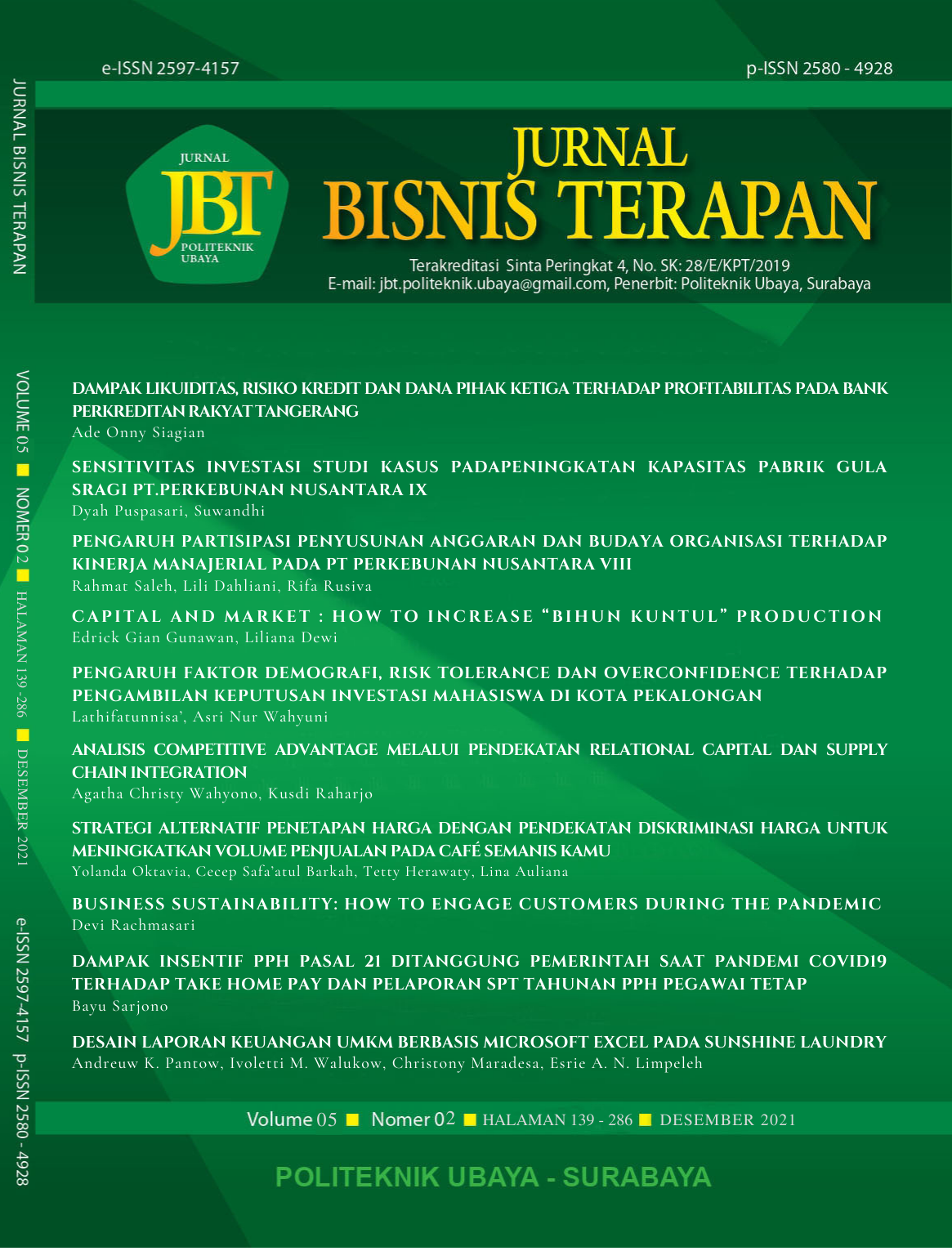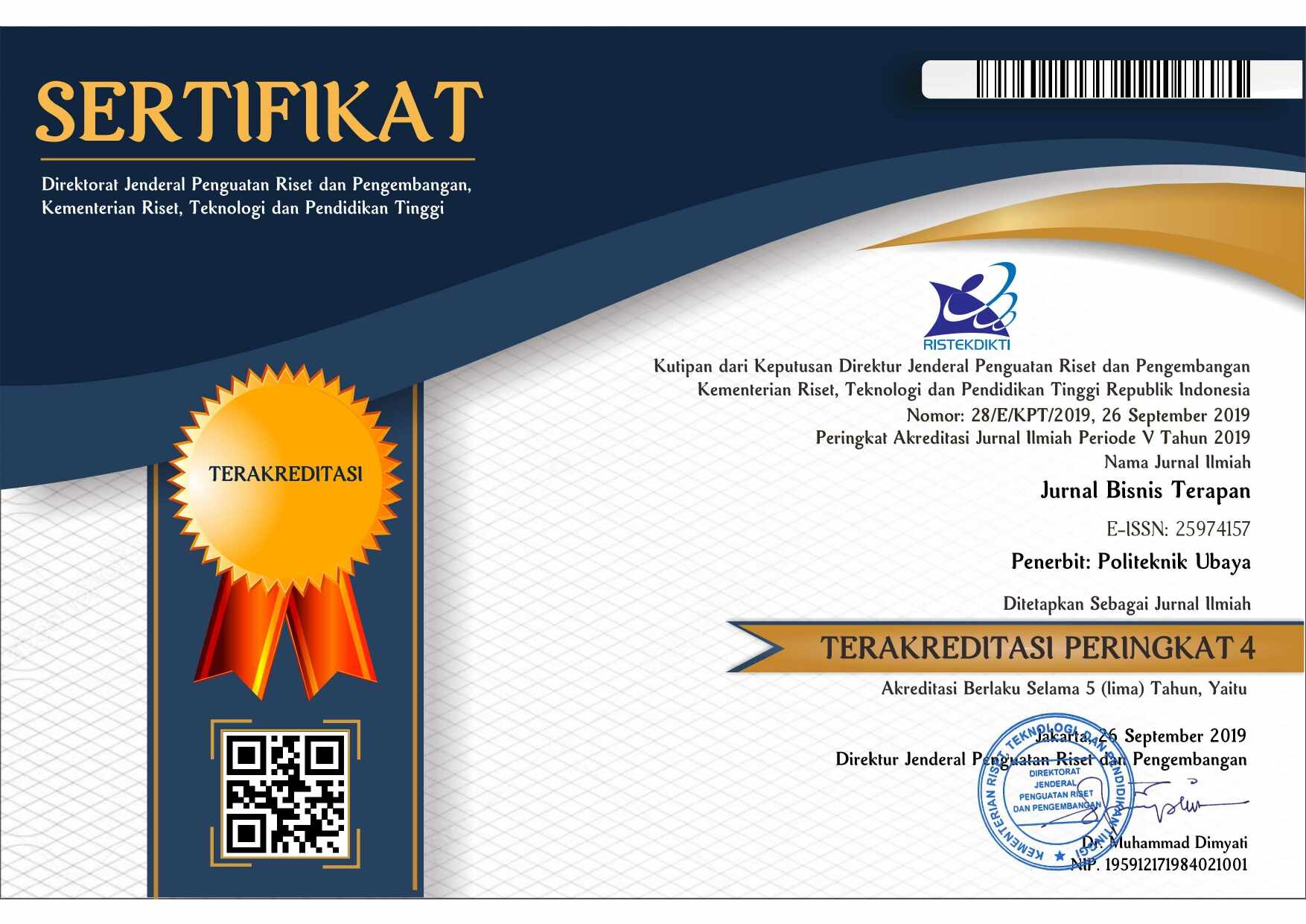ANALISIS COMPETITIVE ADVANTAGE MELALUI PENDEKATAN RELATIONAL CAPITAL DAN SUPPLY CHAIN INTEGRATION
 Abstract Views:
408 times
Abstract Views:
408 times
 PDF Downloads:
625 times
PDF Downloads:
625 times
Abstract
This research aims to examine the effect of relational capital to competitive advantage through supply chain integration. Research method in this study was explanatory research with a quantitative approach. This Research method used explanatory research with a quantitative approach. The object of this research was in four districts of East Java at Nganjuk, Kediri, Malang and Probolinggo which are centers of onion production that have the similar environmental conditions. The sampling method in this study used multistage proportional random sampling. There were 200 respondents as a sample of this research. Data analysis usedpath analysis method by software SPSS 23. The results showed that the relational capital has a positive but not significant effect on the supply chain integration and relational capital has a positive and significant effect on the competitive advantage
Downloads
References
Badan Pusat Statistik. 2018. Pertumbuhan Ekonomi Indonesia Triwulan I-2018 No.
/05/Th.XXI.
Badan Pusat Statistik. 2015. Katalog. Distribusi Perdagangan Komoditas Bawang Merah
Indonesia 2015
Barney, J. 1991. Firm resources and sustained competitive advantage. Journal of
Management, 17(1), 99–120.
Barney, Jay. B., 2007. Gaining and Sustaining Competitive Advantage. New Jersey:
Pearson Prentice-Hall.
Boossabong P, Taylor MF. 2009. Impact of trade liberalization on the agricultural
sector and adjustment policy: the case of shallot plantations in northeastern
Thailand. Kasetsart J. (Soc. Sci) 30 : 323 – 337.
Collis, D.J., 1991. A Resource-Based Analysis Of Global Competition: The Case Of The
Bearings Industry. Strategic Management Journal. 12 (1): . 49- 68.
Collins, J. D. Dan M. A. Hitt, 2006. Leveraging Tacit Knowledge In Alliances: The
Importance Of Using Relational Capabilities To Build And Leverage Relational
Capital. Journal Of Engineering And Technology Management, 23 (3): 147-167.
De Castro, G., M., And Saez, P. L., And Lopez, J., 2004. The Role Of Corporate
Reputation In Developing Relational Capital. Journal Of Intellectual Capital, 5(1)
-585.
Direktorat Jenderal Perdagangan Dalam Negeri Kementerian Perdagangan. Profil
Komoditas Barang Kebutuhan Pokok Dan Barang Penting Komoditas Bawang. 2016
Dominick, Salvatore. 1997. Ekonomi Internasional. edisi 5 cetak 1. Erlangga, Jakarta
Eorter, Michae. 1993. Keunggulan Bersaing: Menciptakan dan Mempertahankan
Kinerja Unggul. PT. Gramedia, Jakarta.
Esterhuizen, Dirk, J.V. Royen and Luc D’Haese. 2008. An Evaluation of The
Competitiveness Sector in South Afrika. Advanced in Competitiveness Research 16(1-2): 31-46.
Fred R. David. 2009. Manajemen Strategis. Salemba Empat Jakarta .
Flynn, B.B., Huo, B. & Zhao, X., 2010. The Impact Of Supply Chain Integration On
Performance: A Contingency And Configuration Approach. Journal Of Operations Management, 28(1), Pp.58–71.
Fuad, Zainul, Aenurofik Dan Rosyid, 2015. Belenggu Tengkulak Atas Pembudidaya
Lele: Relasi Patron-Klien Budidaya Lele Di Wono Tunggal Jawa Tengah. Jurnal
Hukum Islam (JHI), 13(2): 88-98.
Fransiskus Randa dan Ariyanto Solon. 2012. Pengaruh Modal Intelektual Terhadap Nilai
Perusahaan (Studi Empiris pada Perusahaan Manufaktur yang Terdaftar di Bursa Efek Indonesia). Jurnal Sistem Informasi Manajemen dan Akuntansi, Vol 10 No 1 April 2012, Fakultas Ekonomi UAJ Makassar, 2012, hal. 29
Frohlich, M. T. & Westbrook, R., 2001. Arcs Of Integration: An International Study Of
Supply Chain Strategies. Journal Of Operations Management, 19, 185-200.
Hamidin, Dini Dan Surendro, K. 2010. Model Supply Chain Management Dalam
Perspektif Teknologi. Seminar Dan Call For Paper Munas Aptikom
Hitt, M.A., Ireland, R.D., Hoskisson, R.W. 2001. Strategy Management Competitiveness
And Globalization. West Publishing Company.
Inda Sukati, dkk. 2012. Competitive Advantage Through Supply Chain Responsiveness
And Supply Chain Integration. Faculty Of Management And Human Resource Development Universiti Teknologi Malaysia. International Journal Of Business And
Commerce 1( 7): Mar 2012[01-11]
Indriantoro Dan Supomo. 2009. Metode Penelitian Bisnis. Edisi Pertama. Yogyakarta: BPFE.
Johanisson, B., 1998. Personal Networks In Emerging Knowledge-Based Firms: Spatial
And Functional Patterns. Entrepreneurship And Regional Development, 10. 297-312
Kale, P., Singh, H., Perlmutter, H., 2000. Learning And Protection Of Proprietary Assets
In Strategic Alliances: Building Relational Capital. Strategic Management Journal. 21
(2), 217–228.
Kementrian Pertanian Republik Indonesia. 2015. Outlook Komoditi Bawang Merah 2015.
(Online) Di Unduh Dari: Http ://Epublikasi.Setjen.Pertanian.Go.Id /Epublikasi/Outlook/2015/Outlook_Horti/Outlook_Bawangmerah_2013/Files/Assets/Downloads/Publication.Pdf ( 3 Oktober 2018)
Luthans, Fred, Youssef, Carolyn M., Avolio, Bruce J., 2007. Psychological Capital :Developing The Human Competitive Edge. New York : Oxford Uiversity Press
Mata, F., W. Fuerst, And J. Barney, 1995. Information Technology And Sustained Competitive
Advantage: A Resource-Based Analysis. MIS Quarterly 19(4), 487–505.
Moeheriono. 2012. Pengukuran Kinerja Berbasis Kompetensi. Jakarta: Raja Grafindo
Persada.
Moran, Florencia., Palmer, David., Borstoff, Patricia C. 2007. An exploratory analysis of the
relationship between organizational culture, regional culture, causal ambiguity and competitive advantage in an international setting. Journal of International Business Research, Vol. 6, No. 1
Morissan. 2012. Metode Penelitian Survei. Jakarta: Prenada Media Group.
Nazir, Mohammad. 2014. Metode Penelitian Bisnis. Bogor: Ghalia Indo.
Ngah, Rohana And Ibrahim, Abdul Razak, 2009. The Relationship Of Intellectual Capital,
Innovation Dan Organizational Performance: A Preliminary Study In Malaysian SMEs. International Journal Of Management Innovation Systems Vol. 1 No. 1:E1, Pp. 1-13.
O’Leary, BS, Lindholm, ML, Whitford, RA, Freeman, SE., 2002. Selecting The Best And
Brightest: Leveraging Human Capital. Human Resource Management, Fall, Vol. 41, No. 3, Pp. 325-340.
Porter ME. 1999. The Competitive Advantage of Nations. New York (US): The Free
Press.
Pujawan, I. 2005. Supply Chain Management. Surabaya: Guna Widya.
Pusat Pengkajian Perdagangan Dalam Negeri Badan Pengkajian Dan Pengembangan
Perdagangan Kementerian Perdagangan Republik Indonesia. 2017. Analisis Perkembangan Harga Bahan Pangan Pokok Di Pasar Domestik Dan Internasional
Pusat Data Dan Sistem Informasi Pertanian Sekretariat Jenderal - Kementerian Pertanian.
OUTLOOK BAWANG MERAH
Reefke, H., Sundaram, D., 2016. Key Themes And Research Opportunities In
Sustainable Supply Chain Management – Identification And Evaluation. Omega 66, 1–17.
Roos, Goran and Roos, Johan, 1997. Measuring your Company’s Intellectual
Performance, International Journal of Strategic Management: Long Range Planning. Vol. 30 No. 3, pp. 413-426
Saa-Perez & Garcia-Falcon. 2002. A Resource-Based View Of Human Resource
Management And Organizational Capabilities Development. International Journal Of Human Resource Management, Vol. 13, No.1, PP. 123-140
Salvador, Fabrizio., Cipriano Forza, Manus Rungtusanatham, Thomas Y. Choi. 2001. Supply
Chain Interactions And Time-Related Performances: An Operations Management Perspective. International Journal Of Operations & Production Management, Vol. 21 No. 4, 2001, Pp. 461-475.
Sarason, Yolanda dan Tegarden, Linda F. (2003). The Erosion of the Competitive
Advantage of Strategic Planning: A Configuration Theory and Resource Based View. Journal of Business and Management, Vol. 9, No1.
Schoenherr T, Swink M. 2011. Revisiting The Arcs Of Integration : Cross-Validations And
Extensions. Journal Of Operations Management. 30:99-115.
Schoenherr, T. & Swink, M., 2012. Revisiting The Arcs Of Integration: Cross-Validations And
Extensions. Journal Of Operations Management, 30(2), Pp.99–115
Setiawan, Ahmad Ikhwan Dan Reza Rahardian. 2005. Pengaruh Pola Integrasi Supply Chain
Management Terhadap Performa Perusahaan Pada Industri Jasa Makanan Di Surakarta. Jurnal Bisnis & Manajemen. Vol 05, No.1
Siagian. Yolanda M. 2005. Aplikasi Supply Chain Management Dalam Dunia Bisnis.
Jakarta : Grasindo
Simchi-Levi, D., Kaminsky, P., Simchi-Levi, E., & Bishop, W. 2003. Designing And
Managing The Supply Chain. Boston: Mcgraw-Hill
Simchi-Levi, D., Kaminsky, P., & Simchi-Levi, E. 2004. Managing The Supply
Chain: The Definitive Guide For The Business Professional. New York: Mcgraw-Hill.
Siti Nur 'Atikah Zulkiffli Dan Nelson Perera. 2011.The Influence Of Levels Of Supply Chain Integration On The Relationship Between Corporate Competitive Capabilities And Business Performance: Evidence From Malaysian SMEs. University Of Wollongong. Sydney Business School – Papers
Strandskov, Jesper. 2006. Sources of competitive advantages and business performance.
Journal of Business Economics and Management. Volume 7, 2006 - Issue 3
Sugiyono. 2010. Metode Penelitian Pendidikan Pendekatan Kuantitatif, Kualitatif dan R&D.
Bandung: Alfabeta
Susanto, AB. 2014. Manajemen Strategik Komprehensif. Erlangga. Jakarta.
Tim Pemantauan Dan Pengendalian Inflasi (TPI) Kelompok Kerja Nasional Tim Pengendalian Inflasi Daerah (Pokjanas TPID). 2016. Inflasi 2016 Cukup Rendah Dan Berada Dalam Batas Bawah Sasaran Inflasi Bank Indonesia.
Teece, D., Pisano, G., & Shuen, A. 1997. Dynamic Capabilities And Strategic Management . Strategic Management Journal. Vol. 18: Pg. 509-533.
Tewu. M. E. 2015. Peranan Sumber Daya Manusia Dalam Meningkatkan Aktivitas Kelompok Tani Di Desa Tember. E-Journal “Acta Diurna” Volume IV. No.3. Tahun 2015.Tjiptono, Fandy. 2007. Strategi Pemasaran. Edisi Kedua. Yogyakarta : Andi.
Turban, E., King, D., Mckay, J., Marshall, P., Lee, J., & Viehland, D. 2008. Electronic
Commerce 2008 A Managerial Perspective. New Jersey: Pearson Education, Inc.
Van Der Vorst J. G. A. J., 2004.Supply Chain Management: Theory And Practices,
The Emerging World Of Chains & Networks. Elsevier, Hoofd-Stuk 2.1, Wageningen.
Van Der Vaart, Taco; Cristina Gimenez; Dan Dirk Pieter Van Donk. 2012. Supply Chain
Integration And Performance: The Impact Of Bussiness Conditions. University Of Groningen.
Welbourne, T.M., 2007. Employee Engagement: Beyond The Fad And Into The Executive
Suite. Executive Forum.
Welbourne T.M. 2008. Relational Capital: Strategic Advantage For Small And Medium-
Size Enterprises (Smes) Through Negotiation And Collaboration. Journal Of
Business Economy, 18(5): 438-492.
Wenli, Li , Paul K. Humphreys , Andy C.L. Yeungc , T.C. Edwin Cheng. 2007. The
Impact Of Specific Supplier Development Efforts On Buyer Competitive Advantage:
An Empirical Model. Int. J. Production Economics 106 (2007) 230–247
Wernerfelt, B. 1984. A Resource-Based View Of The Firm. Strategic Management Journal, 171-180.
Wernerfelt Birger. 1995. The Resource Based View of The Firm: Ten Years After.
Strategic Management Journal, 16( 3), 171-174.
Wilk, E.D., And Fensterseifer, J.E. 2003. Use Of Resource-Based View In Industrial
Cluster Strategic Analysis. International Journal Of Operations & Production
Management. Vol. 23: 995.
Yubing Yu & Baofeng Huo. 2017. The Impact Of Relational Capital On Supplier Quality
Integration And Operational Performance. Alogistics And E-Commerce College,
Zhejiang Wanli University, Ningbo, People’s Republic Of China; Bschool Of
Management, Zhejiang University, Hangzhou, People’s Republic Of China. Total
Quality Management, 2017.
Yulliatin. 2008. Pengembangan Indikator Penilaian Kinerja Supply Chain Pada Proyek
Konstruksi Bangunan Gedung. Tesis Magister Manajemen Dan Rekayasa Konstruksi,
Institut Teknologi Bandung.


This work is licensed under a Creative Commons Attribution-NonCommercial-ShareAlike 4.0 International License.

Ciptaan disebarluaskan di bawah Lisensi Creative Commons Atribusi-NonKomersial-BerbagiSerupa 4.0 Internasional.
-
Articles published in Jurnal Bisnis Terapan are licensed under a Creative Commons Attribution-NonCommercial-ShareAlike 4.0 International (CC BY-NC-SA 4.0) license, which permits anyone to copy, transform, or redistribute articles for any lawful purpose in any medium, provided appropriate credit is given to the original author(s) and Jurnal Bisnis Terapan is recognized as its original publisher. A link to this license should also be provided. Any derivative work of an article published in Jurnal Bisnis Terapan must also be shared under the same (or compatible) license.
-
Both copyright and publishing rights on articles are retained by the respective author(s), without restrictions. Only a non-exclusive license is granted to Jurnal Bisnis Terapan to publish the article and identify itself as its original publisher.

 DOI:
DOI:






